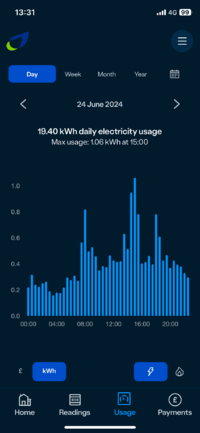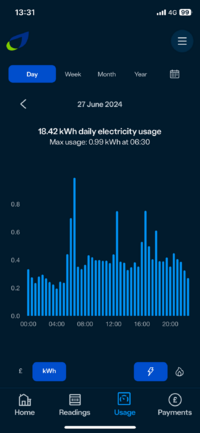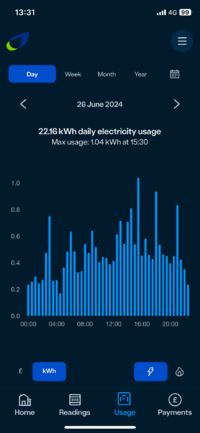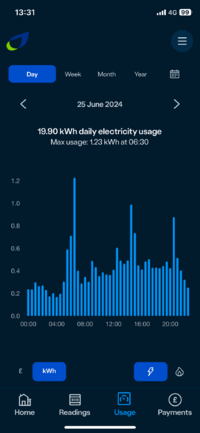Welcome to Tesla Motors Club
Discuss Tesla's Model S, Model 3, Model X, Model Y, Cybertruck, Roadster and More.
Register
Install the app
How to install the app on iOS
You can install our site as a web app on your iOS device by utilizing the Add to Home Screen feature in Safari. Please see this thread for more details on this.
Note: This feature may not be available in some browsers.
-
Want to remove ads? Register an account and login to see fewer ads, and become a Supporting Member to remove almost all ads.
You are using an out of date browser. It may not display this or other websites correctly.
You should upgrade or use an alternative browser.
You should upgrade or use an alternative browser.
Powerwall 3
- Thread starter PITA
- Start date
MikeChicago
Member
I have two in my garage. Just installed this week. Tesla is coming out next week to finish the electrical work. Panels are up, too. Can’t wait for it to be operational.
I can confirm they are LFP batteries. You guys are in for a treat over there!
I can confirm they are LFP batteries. You guys are in for a treat over there!
ACarneiro
Active Member
What I would REALLY like to see for Europe is full three-phase support and what the expansion packs are all about...I have two in my garage. Just installed this week. Tesla is coming out next week to finish the electrical work. Panels are up, too. Can’t wait for it to be operational.
I can confirm they are LFP batteries. You guys are in for a treat over there!
An export of 16A (3.68kW) per phase is what everyone gets under G98 notification. With a G99 application, you can go all the way up to whatever your DNO allows for your particular circumstance. Where I live, in a fairly big housing development, they’re allowing 10kW export without breaking a sweat. Even if the DNO put a limit on your export, you can still be allowed to have an inverter with a higher output, as long as you don’t export more than what the DNO limit you to (G100).
So the PW3 with its 11kW output would still be perfectly usable in many situations, including in power outages.
Right, but the majority of people will be installing it with the capability of exporting energy, for load shifting, taking advantage of overnight charging at cheap rates and re-exporting at peak times in combination with any solar.
I’m pretty sure that any home battery connected via AC needs that approval anyway, it’s only DC batteries that connect on the solar side of the inverter that can escape the requirement if I recall correctly
Hi there I have been reading the discussion which has been really helpful. I have a question if you can kindly help. I live in the UK looking to install 2 PW3 with gateway as daily usage is around 9. I was to be 100% off the grid after 5am when my British Gas 7.9p tariff finishes and just rely on the batteries. I see that PW3 supports 11.5 discharge. I need someone to help explain as the installer is saying we need to do a G99 applicable to see if they will support 11.5 discharge. When I put on mums stair life, under floor heating, hob, dishwasher , washing machine Ketttle etc max was hitting 9 bordering 10. I purely want to avoid a situation where all this is on and battery can only support so much and then it goes to the grid at 27p peak tariff. Reading what you have said does not mean that when they apply saying house has two batteries at 11.5 discharge each they might only support 5 and hence discharge would be capped and where I use a lot of appliances I won’t take advantage of the discharge available and hence will need to partially use the grid.
Can you kindly explain thank you
Can you kindly explain thank you
Pink Duck
Active Member
That 11.5 kW per PW3 discharge is only when it is sunny by the way. Each still guarantees a steady 7 kW out. You'll need two to meet your 10 kW demand fully. The export agreement will factor in total solar and total battery export capability, likely combining both PW3s and just considering your inverter and standard battery discharge rates.
So if I have two batteries with 11.5 discharge each (I don’t have solar - not intending to install - just want battery storage solution) my installer would fill out G99 go to DNO and inform of my set up. I am not looking to export to the Grid I literally want the batteries to support our home needs and literally after they are fully charged between midnight and 5am not use the grid during peak ours. In this basis can the DNO still restrict and say they can only (for example ) support 5kw. In the case if the installer has to restrict the battery that would mean I have less discharge and more likely rely on grid even though I only want to use this for our home and not interested in exporting anything out. Have I understood this correctly. Thanks again
Pink Duck
Active Member
You may as well set up an export SEG as both PW3s will inevitably end full and beyond your home demand at times. Your installed should report 14 kW as the total system demand (7 kW x 2) or similar. Up to the DNO whether they accept or wish to cap that based on local substation data and grid support.
So long as you talk this through with installer and on-site engineers, all should be fine. It will take several weeks after export MPAN before export contract could be set up anyway. With a single PW2 I had more energy than I could use a year back to ended up exporting for free. That's what your system would also do even if no contract to be rewarded for it, by the way - instead of shutting down inverters (unless DNO cap).
So long as you talk this through with installer and on-site engineers, all should be fine. It will take several weeks after export MPAN before export contract could be set up anyway. With a single PW2 I had more energy than I could use a year back to ended up exporting for free. That's what your system would also do even if no contract to be rewarded for it, by the way - instead of shutting down inverters (unless DNO cap).
Thanks for your help. All this terminology is new to me. What is an export SEG and MPAN. You seem to know a lot which is amazing. I have attached screen shots from my British Gas app showing daily electricity KWh consumption for the past few days. I know from the test that absolute worst gas if I had the hob, underfloor heating, iron, microwave, own, washing machine and tumble driver then we got 8.61 going 9.
At rest the house is using around 700w
The underfloor heating is what will mainly be on from 7am to 8pm is about 2.5w which will be during winter.
Based on the above and the pictures from the data am I doing the right thing by going for 2 Powerwall 3’s or do you think one is sufficient. The main thug for me as I said is I don’t want to go to the grid and be charged the peak rate between 5am and 11:59pm.
I guess is the DNO cap at 5kw per battery then 100% I would need two.
What are your thoughts ? Thanks again
At rest the house is using around 700w
The underfloor heating is what will mainly be on from 7am to 8pm is about 2.5w which will be during winter.
Based on the above and the pictures from the data am I doing the right thing by going for 2 Powerwall 3’s or do you think one is sufficient. The main thug for me as I said is I don’t want to go to the grid and be charged the peak rate between 5am and 11:59pm.
I guess is the DNO cap at 5kw per battery then 100% I would need two.
What are your thoughts ? Thanks again
Attachments
If the DNO cap you then it will be for the entire system - doesn't matter how many batteries you have.I guess is the DNO cap at 5kw per battery then 100% I would need two.
I'd recommend you calculate your total energy usage for the day and get batteries large enough to handle that - don't purchase an extra battery just for handling freak instantaneous peak loads, just pull from the grid for those few seconds that everything is on together. The payback period for a battery that is just there to handle peak loads would be multiple decades.
Thanks Dilly that’s helpful. I am considering Heatable who have offered to install 2 Powerwalls (version 3), gateway and upgrade the consumer unit for £13,995. They offered 25% deposit and 3 years interest free on remaining
Just need to find out from DNO if they would be ok with 11.5kw discharge x 2
Just need to find out from DNO if they would be ok with 11.5kw discharge x 2
That isn't an issue for you, the Powerwall 3 is G100 compliant so your installer will set the export limitation to match your DNO imposed limit, but that does not impact on the load you can put on your batteries for internal use.Just need to find out from DNO if they would be ok with 11.5kw discharge x 2
For example, my Powerwall 2 system was installed with a 3.68kW export limit but that didn't stop me pulling 5kW from it for internal use, nor did it prevent me from grid charging at 5kW either.
That limit was actually incorrectly applied anyway as the DNO gave me 8.68kVA, later increased to 13.68kVA and I then changed my export limit to 10kW.
Doesn't sound like you are going to have much use for the export anyway, but whatever limit the DNO gives you is controlled by the G100 limiter and doesn't impact on your use within the home.
Do check your main house fuse limit though as 2 x PW3 charging at 5kW + an EV at 7kW for example along with any other house loads at night is going to be close to the limit for an 80A fuse, so make sure you have 100A if possible. Also note that the fuse carrier will be labelled as 100A but that is just the limit for the carrier, it doesn't tell you about the fuse that is fitted...
This is absolutely perfect Mark. You answered my exact concern. So in essence even if the DNO limit me, it doesn’t impact my internal use as that’s my main concern as my mother has cancer and the winter is not great so I need to keep the under floor heating on from early morning till evening.
We have a monitor and I checked absolute worse case if we use all appliances during the day when the batteries are fully charged then the max pull will be 8.61 / 9 as we would charge the car from midnight to 5am when the British Gas tariff is 7.9p.
I am looking to upgrade my consumer unit as it currently version 16 and will look to hager unit and as you say ensure it supports 100A fuse at a minimum if not higher.
Thanks again for your advice this has given me a lot of ease
We have a monitor and I checked absolute worse case if we use all appliances during the day when the batteries are fully charged then the max pull will be 8.61 / 9 as we would charge the car from midnight to 5am when the British Gas tariff is 7.9p.
I am looking to upgrade my consumer unit as it currently version 16 and will look to hager unit and as you say ensure it supports 100A fuse at a minimum if not higher.
Thanks again for your advice this has given me a lot of ease
The 80/100A fuse Mark is referring to is the DNO's main fuse, not the breaker in the consumer unit. If you only have a 60 or 80A fuse then only the DNO can upgrade it.I am looking to upgrade my consumer unit as it currently version 16 and will look to hager unit and as you say ensure it supports 100A fuse at a minimum if not higher.
Thank you for clarifyingSEG = Smart Export Guarantee (a contract between your property and energy provider to be remunerated)
MPAN = Meter Point Administration Number (reference used with import and export electricity meters)
Similar threads
- Replies
- 51
- Views
- 3K
- Replies
- 12
- Views
- 1K
- Replies
- 32
- Views
- 2K
- Replies
- 4
- Views
- 981






